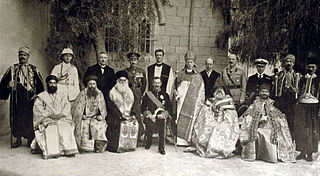Related Research Articles
Dionysius I Telmaharoyo, also known as Dionysius of Tel Mahre, was the Patriarch of Antioch, and head of the Syriac Orthodox Church from 818 until his death in 845.
George of Beltan was the Patriarch of Antioch and head of the Syriac Orthodox Church from 758 until his death in 789 or 790.
Athanasius II Baldoyo, also known as Athanasius of Balad, and Athanasius of Nisibis, was the Patriarch of Antioch and head of the Syriac Orthodox Church from 684 until his death in 687.
Quriaqos of Tagrit was the Patriarch of Antioch, and head of the Syriac Orthodox Church, from 793 until his death in 817. He is commemorated as a saint by the Syriac Orthodox Church in the Martyrology of Rabban Sliba, and his feast day is 13 or 16 August.
Ignatius John XIV bar Shay Allah was the Patriarch of Antioch, and head of the Syriac Orthodox Church from 1483 until his death in 1493.
Elias I of Antioch was the Patriarch of Antioch and head of the Syriac Orthodox Church from 709 until his death in 723. He is commemorated as a saint by the Syriac Orthodox Church in the Martyrology of Rabban Sliba, and his feast day is 3 November.
Athanasius I Gammolo was the Patriarch of Antioch and head of the Syriac Orthodox Church from 594/595 or 603 until his death in 631. He is commemorated as a saint by the Syriac Orthodox Church in the Martyrology of Rabban Sliba, and his feast day is 3 January.
Iwannis I was the Patriarch of Antioch and head of the Syriac Orthodox Church from 739/740 until his death in 754/755.
John IV was the Patriarch of Antioch, and head of the Syriac Orthodox Church from 846 until his death in 873.
Athanasius IV Salhoyo was the Patriarch of Antioch and head of the Syriac Orthodox Church from 986/987 until his death in 1002/1003.
Severus II bar Masqeh was the Patriarch of Antioch and head of the Syriac Orthodox Church from 667/668 until his death in 684. He is commemorated as a saint by the Syriac Orthodox Church.
Dionysius II was the Patriarch of Antioch and head of the Syriac Orthodox Church from 896/897 until his death in 908/909.
Athanasius VI bar Khamoro was the Patriarch of Antioch, and head of the Syriac Orthodox Church from 1091 until his death in 1129.
Julian II, also known as Julian the Roman or Julian the Soldier, was the Patriarch of Antioch and head of the Syriac Orthodox Church from 687 until his death in 708.
Athanasius VII bar Qatra was the Patriarch of Antioch, and head of the Syriac Orthodox Church from 1139 until his death in 1166.

In the Syriac Orthodox Church, the Archbishop of Jerusalem today bears the additional title of Patriarchal Vicar of the Holy Land and Jordan. The see is currently held by Anthimos Jack Yakoub.
The Chronicle of 819, also called the Chronicle of Qarṭmin, is a chronological table of important events and people from the birth of Jesus down to the year AD 819 written in Syriac by an anonymous Miaphysite monk from the monastery of Qarṭmin. It contains lists of the Abbasid caliphs for 785–813 and the Syriac Orthodox patriarchs for 788–819.
Athanasius III was the Patriarch of Antioch and head of the Syriac Orthodox Church from 724 until his death in 739/740.
Isaac I was the Patriarch of Antioch and head of the Syriac Orthodox Church from 755 until his death in 756. Isaac's uncanonical elevation to the patriarchal office has led him to be regarded as an illegitimate patriarch.
The Mor Bar Sauma Monastery was a Syriac Orthodox monastery near Malatya in Turkey. The monastery served as the regular patriarchal residence from the eleventh century until the thirteenth century, and was eventually abandoned in the seventeenth century. It produced five patriarchs and forty-three metropolitan bishops. Between 1074 and 1283 several synods took place at the monastery.